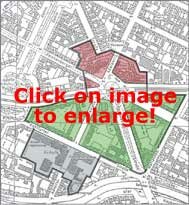soziale stadt - bundestransferstelle
besonderem Entwicklungsbedarf - Soziale Stadt"
Berlin-Kreuzberg Kottbusser Tor |
|||||||||||||||||||||||||||||||||||||||||||||||||||||||||||||||||||||||||||||||||||||||||||||||
|
Ingeborg Beer The fall of the Berlin Wall and the unification of the two halves of the city initiated far-reaching changes in Berlin. Concurrent political transformation processes (new property system, elimination of subventions, locational freedom, etc.,) and structural changes in society (deindustrialisation, internationalisation, etc.) thoroughly unsettled the fabric of the city. The result was conflicting lines of development, new departures and decline, which are reflected in the structure of the city's social space. New "islands of affluence and consumption" confront numerous "problem neighbourhoods" - the reunited Berlin proves to be a city with strong social fractures. Since the mid-1990s, urban development policy has addressed this situation and introduced counter-strategies at various levels to contain further social de-integration in inner-city residential neighbourhoods and the escalation of segregation processes in the city as a whole. In addition to the abolition of the inappropriate occupancy charge and the occupancy commitment for publicly-assisted housing in specified types of area, 15 areas had been selected as a pilot project in early 1999 under the state programme "Socially Oriented Urban Development" to counter decline with the social-space approach of "neighbourhood management."
1. Nature of the area
|
|||||||||||||||||||||||||||||||||||||||||||||||||||||||||||||||||||||||||||||||||||||||||||||||
|
One of these districts is the model area Kottbusser Tor in Kreuzberg. It covers the blocks and parts of blocks immediately surrounding the square Kottbusser Tor. This large-scale housing estate in an inner-city neighbourhood characterised by old development has been one of the most controversial issues in Berlin urban development and housing policy. Motorway planning, comprehensive redevelopment and high-density building mark the stages in the persistently difficult rehabilitation and development history of this area since 1963.
The northern part of the model area is dominated by the "Kreuzberg Centre." A residential and commercial complex built by a private contractor for West German investors in the 1970s as a tax-saving write-off project, the centre was, from an architectural and urban-development point of view, intended to point the way to the future and to upgrade Kreuzberg's image. The southern area is also largely the result of comprehensive redevelopment in the 1970s. The "street slaughter" (1) produced rigorous remodelling and redesign: up against the old tenement housing "a small 'Märkiches Viertel' (high-rise housing estate in the West Berlin district of Reinickendorf)" was inserted "in the heart of Kreuzberg" (2) consisting largely of social-welfare housing. |
 |
Residential, social, and commercial complex "Kreuzberg Centre" on Kottbusser Tor (Source: Ingeborg Beer, Berlin) |
The two areas are separated by the elevated railway viaduct flanked by Skalitzer Strasse, with the station Kottbusser Tor. The square is an important traffic junction and transfer station, and a busy area: the streets converging on the square ensure a high level of traffic, and it is frequented day and night by a large number of people because it is at the intersection of two underground railway lines and the location of several bus stops. It is a major location for banks, retailing, and services (doctors' practices, chemist shops, etc.).
Some 4,350 people live in the model area at present, most do not have a German passport (55.2%). There is a much higher percentage of children and young people than in Kreuzberg and Berlin as a whole.
Two day-care nurseries, a primary school, a centre for the disabled with workshops and a swimming pool, as well as an old-age residence with a leisure centre constitute the infrastructure. The Kreuzberg Centre also houses a mosque. The municipal library and the Kreuzberg Museum are cultural facilities and meeting places of more than local importance.
2. Main Problems and Development Potential 
When the Wall came down, Kreuzberg found itself in the city centre, but hopes that the "Kreuzberg mixture" would stabilise have not been fulfilled, nor have fears that residents would be displaced by an invasion of yuppies and upper-middle class inmigrants. Against this background, the model area now faces the following major problems.
Concentration of migrants and inter-community conflicts: the German and Turkish "middle class" has moved out of the model area, while the poor, older and "deeply rooted" people have remained. New groups of migrants have moved in. Whereas during the 1960s and 1970s most inmigrants were Turkish workers with their families, publicly assisted housing in the area is now occupied by migrants at high risk of exclusion and little chance of integration in the labour market. They include not only relatives and spouses from Turkey but also refugees from Bosnia-Herzegovina and Kosovo, Arab, Kurdish, and Lebanese refugees, asylum seekers, and ethnic German immigrants from eastern Europe. Experts estimate that 80% of residents are not German in origin, and statistics show a 55.2% proportion of foreigners. The remaining German residents feel themselves in the minority and often as the victims of changed circumstances.
Demography and Social Space
|
Kottbusser Tor |
Kreuzberg |
Berlin |
|
|
Size |
approx. 15 ha |
1 038 ha |
89 169 ha |
|
Population (2000) |
4 354 |
145 645 |
3 382 169 |
|
Population decline (1995–2000) |
n.a. |
5.1 % |
2.6 % |
|
Average household size (2000) |
2.8 pers. |
1.9 pers. |
1.9 pers. |
|
Number of dwellings (2000) |
1 576 |
75 334 |
1 862 766 |
|
Vacant dwelling units (2002) |
n.a. |
n.a. |
approx. 5 % |
|
Housing benefit recipients (2000) |
n.a. |
15.9 % |
10.6 % |
|
Unemployment rate (2000) |
23.1 % |
26.2 % |
16.3 % |
|
Social assistance recipients (1998) |
42.2 % |
17.8 % |
7.9 % |
|
Foreign population (2000) |
55.2 % |
33.0 % |
13.1 % |
|
Population under 18 (2000) |
33.2 % |
19.8 % |
17.0 % |
|
Population 65 and older (2000) |
6.8 % |
8.1 % |
14.2 % |
Income poverty and exclusion from the labour market: poverty and social problems are concomitants of the concentration of migrants - but Germans are also massively affected. Many local residents are unemployed and a very high proportion - over 40% - depend on social assistance. Low levels of education and vocational training and language problems make it more difficult to compete even for insecure and badly paid jobs, and bar access to training positions. The stigmatising "address" Kottbusser Tor rapidly reduces any prospects of success with applications. The training and employment situation of foreign young people is particularly difficult. This is the breeding ground for resignation and self-overrating, stylisation and aggression up to and including fundamentalist or nationalistic attitudes.
Overburdened care and educational facilities: given their present structures, the day-care nurseries in the area and, in particular, the Jens Nydahl Primary School are hardly able to help diminish disadvantagement and promote equality of opportunity. A high level of resignation among many teachers and educational staff compounds the problem. The mostly foreign children cannot catch up linguistically in large classes and without extracurricular support for integration (family, neighbourhood, etc.). Since confidence in the school among education-oriented German parents and socially ambitious migrants is waning and encouraging them to move out of the area, the problems are intensifying. For material and cultural reasons, many Turkish and Arab parents to not allow their children to attend kindergarten or use school recreational facilities, thus restricting opportunities for integration.
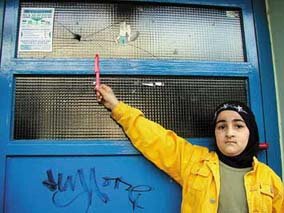 |
Vandalized entrance doors - it upsets the children, too (Source: Ingeborg Beer, Berlin) |
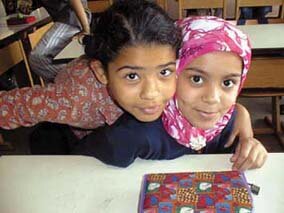 |
An above-average proportion of children of non-German origin live in the model area (Source: Ingeborg Beer, Berlin) |
Neglect of the dwelling environment and public space: the dwelling environs and public spaces have a strong disadvantaging and stigmatising impact - despite the generous size of residential courtyards. Heavy traffic and the lack of sojourn quality is a problem not only for children, and the neglected state of courtyards limits their compensatory function for restricted housing conditions. Resigned authorities promote the "neglect cycle": Why develop a refuse concept when residents don't kept to it? Why repair vandalised door glazing if it will be smashed in again?
Massive public nuisance caused by the drug scene: for over a decade, Kottbusser Tor has been one of the established venues of the drug scene. This has proved one of the biggest sources of problems and conflict. Residents and traders in the Kreuzberg Centre find themselves largely unable to accept or cope with the concomitant nuisances (abandoned syringes, pollution, intimidation, aggression, etc.). Many of the people concerned have given up hope that local solutions can be effective. Initiatives addressed to the political and administrative authorities by the tenants council, local doctors and pharmacists ("Shooting Galleries Now!") have not yet found the desired support. Although there are some cooperative care and councelling structures in place locally, there is nothing in the way of a long-term, viable overall strategy beyond the alternatives of "law and order" versus "toleration of the status quo" that could bring about fundamental changes.
At the same time, the model area Kottbusser Tor has spatial-functional development potential, which could mitigate or compensate existing problems, and possibly even promote new qualities. It is an inner-city location with good traffic connections, and offers excellent conditions for trade, industry and services. There are about 1,000 jobs located in the immediate model area alone. The future letting of vacant commercial premises in the Kreuzberg Centre and other buildings on the square can help strengthen the economic location and develop a differentiated facilities and services structure - as intended by the owners.
Residents' attitudes towards the area range from identification and commitment to resignation and "voting with removal van and wallet." Many local actors and residents don't allow themselves to be discouraged, despite great poverty, social problems, and the uncertain prospects: they put forward ideas, show creativity, seek to make their own way or support each other in their efforts.
In contrast to monostructural large-scale housing estates on the urban fringe, the interactional space between Landwehr Canal and Oranienstraße offers favourable conditions for implementing integration strategies. Life, work, and culture are interwoven here in a great many ways. A few steps away from the "Kreuzberg Centre" the streets are lined by businesses , restaurants, Turkish shops, alternative scene locales, bakeries, bookshops, and artists' studios. Oranienstraße is still one of the most interesting streets in Kreuzberg and Berlin, and attracts many tourists.
On the southern periphery along the Landwehr Canal, attractive apartments for the better-off were built in the 80s on Fraenkelufer, and alternative lifestyles and an attractive pub and bar scene have become established. This, too, can help reinforce integration efforts - especially with regard to cultural and education-oriented strategies.
3. Development Goals and Focal Points of Action
All the problems and resources to be found at the various levels point to the conflict between societal causes and necessary intervention at the local level, between action at the municipal level and the local context - an ambivalence that also determines the development process with regard to goals and the success of measures and projects.
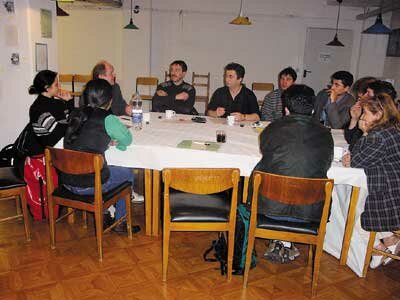 |
Meeting of the business people's association (Source: Reinfried Musch, Berlin) |
|
The superordinate objective with which the development process in the model area began in 1999 was "stabilisation." The demolition of the Kreuzberg Centre, which had been the subject of public debate some months previously, was no longer on the agenda by this point in time, the corporation owning the complex had a new managing director, and the tenants' council had been (re-)activated. It was now a question of neighbourhood management making a visible mark through projects and measures to stop further departures of business people and residents and to offer an alternative motto to the perceptible and visible resignation and neglect on all sides. "Things are looking up again!" The August 1999 integrated plan of action set the following goals and areas of action: |
1. Coordination and networking
2. Strengthening the local economy
3. Improving the employment and qualification situation
4. Enhancing training opportunities
5. Activation and involvement of residents
6. Public relations and image upgrading
7. Improvement of residential and dwelling environmental quality, recuperation of public spaces
8. Further development of the infrastructure in keeping with needs, taking children and young people particularly into account.
Three years have since passed. In Berlin, controversial discussions on the principles of neighbourhood management have since given way to questions about its practical success on the spot. For the model area the results in the focal areas of action that have so far been addressed can be summed up as follows.
Local economy: The focus is on self-employment. Many migrants have chosen self-employment as an alternative to unemployment, but not always successfully owing to a lack of know-how and experience. To promote activation and provide support, a business people's association (IG Kotbusser Tor) was founded, advisory services for start-up firms and for business people, and constant discussions with representatives of banks and finance service providers.
Training, employment, and qualification: in this area, too, concrete progress has been achieved:
- since 1999 some 300 young people have been placed in firms (apprenticeships, training) through the mediation and support of the neighbourhood management;
- provision of jobs and limited qualification measures in the context of events (organisation, security services, jury, etc.) and, to some extent, continuation in sponsored training courses for particularly disadvantaged young people;
- involvement of residents who are unemployed or dependent on transfer payments in dwelling environment and public space development projects;
- the creation of internships and trainee positions in the neighbourhood office KonTor.
Housing and dwelling environs, public spaces: The first "sensation" in this sphere of action was remodelling the staircase in the Kreuzberg Centre. What seemed unspectacular for outsiders was an important step for those more closely involved, especially because the "inauguration" by the senator for urban development and district mayor of Kreuzberg underlined the political significance of the new course. A similar impulse was generated by the new playground at the Kreuzberg Centre, which had been repeatedly demanded since the construction of the complex but saw the light of day only in 2000: "A long dream has become reality," to quote a representative of the tenants at the opening. Structural improvements to building entrances and stairwells and the redesign of a residential courtyard achieved several objectives at the same time: the involvement of residents who were jobless or dependent on social assistance reduced unemployment and income poverty; remedying the deficits enhanced use and sojourn quality; participation by residents increased acceptance and respect for the measures taken; and, finally, the housing company was spared expensive maintenance work in certain areas while effective presentation counteracted the negative image.
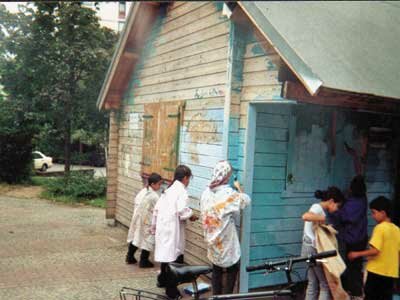 |
Children paint the Bamula Hut in Block 87 (Source: Kotti e.V., Berlin) |
|
Social infrastructure: with the collaboration of residents amenities and events have been set up and organised in the Kreuzberg Centre and the courtyards (table-tennis room, Café Aktuell, neighbourhood get together of the residents' group Bizim Ev and Bambula Hut). In future the school will be receiving more attention. In the context of local programme support, a project week and a children's conference "Kids on the Block" were organised at the Jens Nydahl Primary School, focussing on the interests and wishes of children, which involved parents and promoted links with the school. A central project that has since been launched with the help of financial support has been the redesign of the school playground. |
4. Key Projects 
Not all projects have the same value. The neighbourhood management defines the following measures as "key projects," because they address central problems and are intended to achieve a high degree of networking and effectivity.
This year the remodelling of Kottbusser Tor Square will begin. For this project, which goes far beyond the requirements of immediate residents, integrated action will mean the involvement of authorities at the city and political levels. The project is to be carried out under a job-creation scheme, planned by the administrative authorities, coordinated locally, and effectively presented: this will require the integration of potent partners like Berlin Public Transport and those bearing responsibility for drug policy in the process.
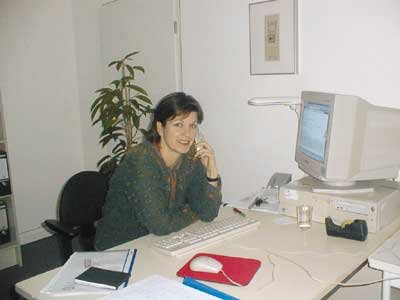 |
One of the first firm founders in the new premises (Source: Ingeborg Beer, Berlin) |
|
In the Kreuzberg Centre young firms are offered office space and organisational assistance at favourable financial conditions in the "Founders' Gallery". Users share a conference room, a tea kitchen, fax machine and photocopier. The first "founders" have already set up business. Various employers and advisory facilities have set up an association, so that jobs have been created and qualified employment offered for people under community programmes. The multi-goal Homework Circle project (Schularbeitenzirkel - SCHATZ) was launched on the initiative of residents. It addresses children from 7th grade who can receive help with their homework from two teachers (under service contract). The premises are made available in the Kreuzberg Centre by the owner at favourable conditions. Renovation as well as material and fees are financed by the "Socially Integrative City" programme and the neighbourhood fund. This project proved a stimulus for other sponsors, and inspired other homework projects for children in the model area. |
The project "Berlin at Kottbusser Tor: Citizens Create A District Museum" was initiated by the "Society for the Study and Presentation of Kreuzberg History." It has been financed by the neighbourhood fund and addresses active residents with an interest in education and culture. One floor of the Kreuzberg Museum will be devoted to an exhibition (pictures, films, models, reminiscences, and biographical portraits) in which residents present the history of the neighbourhood and organise discussions. This project, too, is designed to foster employment.
In restructuring the entrance area of a residential block under a job creation scheme, a caretaker's lodge was installed, and in the Kreuzberg Centre a security service was set up. In both locations residents felt a strong need for greater security in the immediate residential environs. The caretaker's lodge also has the function of a centre where residents can obtain information, leave messages, and organise exchanges with others. This project has meanwhile been extended to include a "culture lodge": every month small events are staged in the foyer of the building - financed by the action fund and organised by Neighbourhood Communication (KOM - Kommunikation im Kiez), a joint project of the housing company GSW and the sponsor Lowtec.
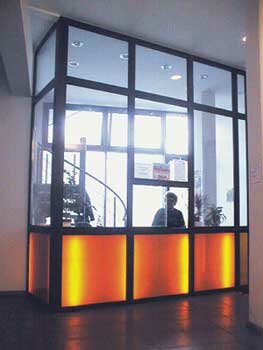 |
The caretaker's lodge at 37 Admiralstraße has been extended to form a "Culture Lodge," which has met with a great deal of approval from residents (Source: Ingeborg Beer, Berlin) |
QuartiersRap Kotti (Kotti Neighbourhood Rap) is an event organised jointly by the neighbourhood management and young people, which was staged for the first time in 1999. Once a year some 20 rap groups from the German hiphop scene meet to compete for the best texts and most successful presentation. A jury - whose members are taken from the "scene" and among residents - select three winners. The prizes are contributed by the housing companies and landlord groups, and the event is promoted nationwide by a sponsor. Many actors from the area (associations, residents, firms) participate in the staging of the event, young people take responsibility for particular tasks up to and including allocation of funds. They are given employment opportunities, some have been integrated into the primary labour market (security service). Some 600 spectators were counted at the latest event in September 2001. Particular effect: increased acceptance and image enhancement beyond the limits of the neighbourhood.
5. Management and Organisation 
Particularly important for Berlin and the model area is top-level political support for the "Socially Integrative City" programme philosophy from the governing mayor and the senator for urban development. The Senate Department of Urban Development is responsible for the strategic steering and political control of social-oriented urban development. A "Socially Integrative City" unit was set up. The Senate Department is competent in the follow areas: the coordination of specialised sections at the senate level, controlling (evaluation), networking and the exchange of experience between all neighbourhood-management areas, further education and the provision of information material, the organisation of conferences and public relations, etc.
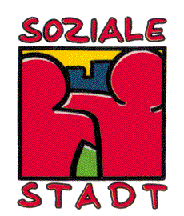 |
Logo "Socially Integrative City" for Berlin (Source: Berlin Senate Department of Urban Development) |
At the senate department and the district government level a steering group is responsible for interlinking existing instruments and financial resources. The district steering group brings together all competent organisational units of the district government, the representative of the senate department and of the neighbourhood management, and, when required, other institutions and groups. However, district reform (merging of the districts Kreuzberg and Friedrichshain) with the concomitant shifts in competence and political responsibilities has severely hampered control and cooperation for a considerable time. Furthermore, the district lacks money, and many an official regards the devolution of tasks to the area as threatening his influence and powers, and sees a connection between job cuts in administration and the development of neighbourhood management.
In February 1999 the neighbourhood management team took up work in the model area. The SPI Foundation - Urban Development Division - was commissioned by the Senate Department of Urban Development in consultation with the district of Kreuzberg to operate the neighbourhood management. The district bureau KonTor is located in the Kreuzberg Centre. The chief tasks of the neighbourhood management include cooperation and networking between actors There is also intensive cooperation with the administrative authorities at the district and senate levels. The senate and district administrative coordinators attend neighbourhood management team meetings. The team is composed of five people each with a half-time position. They are assigned clearly defined "departments" or areas of action (employment and qualification, training positions and public relations, local business, area coordination, action and neighbourhood funds), so that collaboration on a division of labour basis is necessary. The pressure to succeed and to work efficiently is high.
 |
Steering bodies (Source: Berlin Senate Department of Urban Development) |
The "organisation group" plays a key role in coordination and networking between actors (district bureau, landlords, political parties, police, planners, administrative authorities, schools, business people, employment authorities, initiatives, associations, residents) in implementing the integrated plan of action. In this circle implementation-oriented measures are presented and discussed and procedure coordinated. This "body" partly recalls traditional Kreuzberg participation and coordination structures and partly breaks new ground.
6. Activation, Participation, and Public Relations 
Since the neighbourhood management took on the job of developing and implementing the integrated plan of action - via multipliers, personal discussions, and cultural events - a "cooperation and participation spiral" has been set in motion, which is currently concentrated on two levels.
First, there is the level of the multipliers, experts and actors with their own interests. They include landlords and institutions, associations and action groups. In the forefront of this cooperation and participation structure are individual projects and structural topics connected with employment and the organisation of residents through the Kotti association.
On the other hand, structures of resident participation and co-decision have been developed, whose point of departure has been innovative political strategies in urban development policy and administration: the action fund and the neighbourhood fund. The focus is on both participation and activation: residents, associations, and civic action groups can in the long term become "actors" in neighbourhood decision-making and development, structures that are self-sufficient and susceptible to amelioration can develop.
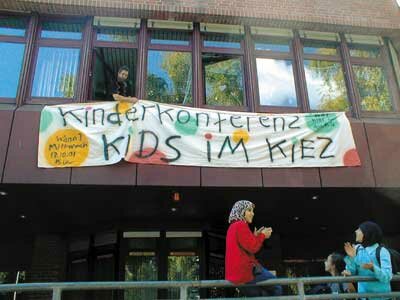 |
Invitation to the children's conference at the Jens Nydahl School on 17 October 2001 (Source: Ingeborg Beer, Berlin) |
|
Action fund - major impact with modest resources: Since October 2000 the action fund has been available with an annual budget of DM 30,000. Ten elected representatives from the area on the committee of awards - residents, caretakers, business people, initiatives, etc. - decide on the utilisation of this money. Project applications can be submitted by residents as well as by associations and citizens' groups. Whereas in the first phase projects were proposed primarily by private organisations, ideas and project proposals now come increasingly from residents. The neighbourhood management is withdrawing more and more from this process because there are already signs that a "self-sufficient structure" is forming. Twenty-four projects have so far been realised with the aid of the action fund. They have not all been concerned with eliminating material defects or with constructional measures; there have been an increasing number of projects aimed at enhancing interpersonal community life (exhibitions, festivals, security measures, greening campaign, etc.). |
|
|
Neighbourhood fund - the model area becomes a millionaire: In addition to the support programme projects mediated by the Kottbusser Tor neighbourhood management, the Senate Department of Urban Development made a "neighbourhood fund" totalling some DM 1,000,000 available to residents of the model area - and to other neighbourhood management areas. A jury of thirty, composed in the majority of residents randomly selected on the basis of residents' registration office records, decides on the application of funds. In addition to individual residents, the jury includes representatives of initiatives, institutions, associations, and active private persons: fifteen members are entitled to vote and fifteen representatives are entitled to speak. |
|
 |
Neighbourhood fund: composition of the committee of awards (Source: Berlin Senate Department of Urban Development) |
The jury met for the first time on 14 May 2001. The district bureau KonTor operates as agency, this is where project applications are received and residents advised on filing applications. Meetings are not public. Twenty-one projects have so far been processed, and fifteen realised. They include the homework circle, security service in the Kreuzberg Centre, children's culture summer, afternoon read-aloud sessions in the library, roof planting to improve the environment, support for the children's farmyard, etc.
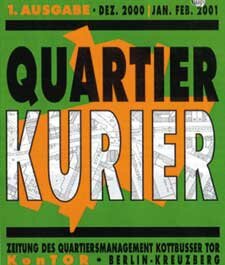 |
The "Quartierkurier" - Kottbusser Tor neighbourhood management newspaper (Source: Reinfried Musch, Berlin) |
Public relations and image building are crucial cross-sectional tasks for all areas of action. Since January 2001, the multilingual neighbourhood newspaper "Quartierkurier" has been keeping residents informed about progress and events. Festivals, exhibitions, readings, and graffiti campaigns are designed to promote neighbourhood life. Two films on the Kreuzberg Centre and young people from the area - both made by a Kreuzberg producer in collaboration with various resident groups - convey both "internally" and "externally" that the people here have a great deal of identification and ideas to contribute.
7. Conclusion: From "Deprived Area" to "Location with a Future"? 
The neighbourhood management's first-stage goal of stabilising the area appears to have been attained in the main, and the spiral of decline has been stopped. There has been investment in greater security and cleanliness, associated with new employment opportunities, new recreational facilities for children and young people, and places for mothers to meet; and the application of public funds has been linked with the development of self-sufficient participation structures. Success has been achieved in creating training, employment, and earning opportunities for foreign young people, in particular, and in integrating them in the labour market. In certain areas residential and business location quality has been improved, dwelling vacancies have been reduced, and a start has been made in mitigating local disadvantaging effects. With the neighbourhood fund, the action fund, and employment and participation projects, many people have become active (again) and have taken on new responsibilities. The external image of the area has also improved. The actors involved are even convinced that "the location has a future again."
It would nevertheless be premature to regard these processes and changes as signs of a perceptible "upward spiral." No-one expects poverty and exclusion to be eliminated at the local level, and everyone concerned with the process knows that it will take years to break through the entrenched "culture of dependence" and to establish the conditions required for a sustainable improvement in economic and social integration. Most residents are still unemployed and dependent on social assistance. Many have not yet been reached by the activation and participation models that have so far been implemented. The drug problem in public spaces will remain a major challenge and - like education, work, and transport - will need to be taken still more strongly into account in strategies for the city as a whole.
"We're switching over" is the current neighbourhood management motto in the model area: to more education and qualifications, to more comprehensive and open participation structures, to greater involvement of potent partners from industry in the development process, from project to milieu-oriented approaches. Persistence and staying power will continue to be needed. Nevertheless: The "Socially Integrative City" has gained a bit of ground against "social segregation" in Berlin.
References
(1) Dieter Hoffmann-Axthelm, Straßenschlachtung, Berlin 1984, p 24. ![]()
(2) Heinrich Kaak, Kreuzberg, Berlin 1988, p 26. ![]()
Im Auftrag des BMVBS vertreten durch das BBR. Zuletzt geändert am 25.05.2005

